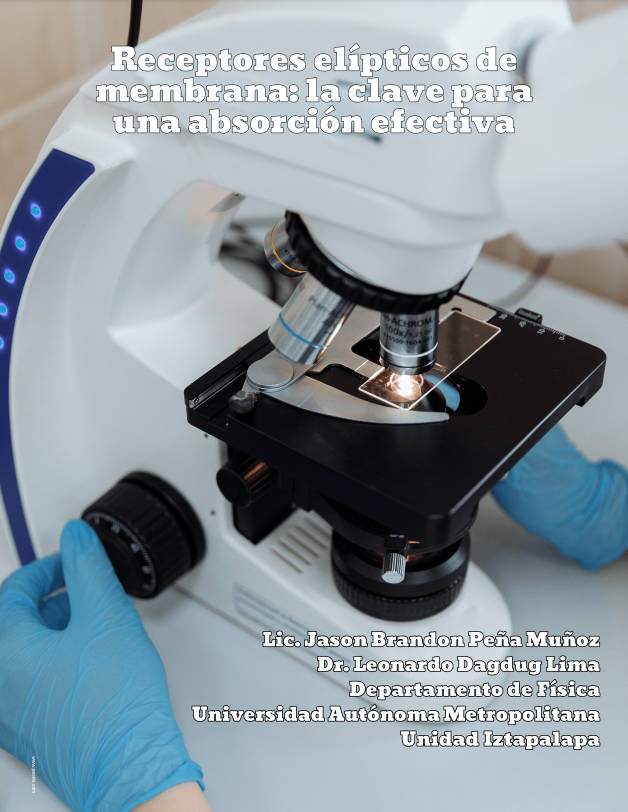Receptores elípticos de membrana: la clave para una absorción efectiva
Abstract
Models of molecules transport through diffusion offer an important insight into the description of microscopic phenomena in nature. In this article we go through some models of chemoreception, from the perfect spherical absorbent, the use of Weber’s disk, and the develop of Berg and Purcell approach, to Zwanzig and Szabo generalized solution where interference effect and partially absorbing receptors are considered. A discussion on the conditions under which this effect is truly necessary is presented. Afterwards, we extrapolate Dudko’s solution using a dimensional comparation for rate constant diffusion to receptors of arbitrary shape on a spherical cell and contrast the absorption effectiveness on circular and elliptical chemoreceptors using as reference the perfect spherical absorber. We found that the elliptical geometry offers a plausible model in cellular anatomy, a result that could explain the structure variation on chemoreceptors and the observed physiological changes on cells.
Downloads
References
Berg, H. C. & Purcell, E. M. (1977). Physics of chemoreception. Biophysical Journal, 20(2), 193-219. doi:10.1016/s0006- 3495(77)85544-6
Berezhkovskii, A. M., Dagdug, L., Lizunov, V. A., Zimmerberg, J. & Bezrukov, S. M. (2012). Communication: Clusters of absorbing disks on a reflection wall: Competition for diffusing particles. The Journal of Chemical Physics, 136(21), 211102. doi:10.1063/1.4726015
Dagdug, L., Vázquez, M.-V., Berezhkovskii, A. M., & Zitserman, V. Y. (2016). Boundary homogenization for a sphere with an absorbing cap of arbitrary size. The Journal of Chemical Physics, 145(21), 214101. doi:10.1063/1.4968598
Douglas A. Lauffenburger, Jennifer J. Linderman. (1993). Receptors Models for Binding, Trafficking and Signaling. New York, USA: Oxford University Press.
Dudko, O.k., Berezhkovskii, A. M. & Weiss, G. H. (2004). Rate constant for diffusion-influenced ligand binding to receptors of arbitrary shape on a cell surface. The Journal of Chemical Physics, 121(3), 1562-1565. doi:10.1063/1.1763137
Eliezer Braun. (1995). Un Movimiento en Zigzag. México, DF: Fondo de Cultura Económica
Galanti, Marta & Fanelli, Duccio & Traytak, Sergey & Piazza, Francesco. (2018). Diffusion to Capture and the Concept of Diffusive Interactions.
Northrup, S. H. (1988). Diffusion-controlled ligand binding to multiple competing cell-bound receptors. The Journal of Physical Chemistry, 92(20), 5847–5850. doi:10.1021/j100331a060
Reece, J. B., Urry, L. A., Cain, M. L., Wasserman, S. A., Minorsky, P. V. y Jackson, R. B. (2011). Cell communication. Campbell biology (210-231). San Francisco, CA: Pearson.
R. Phillips, J. Kondev, J. Theriot, H. G. Garcia. (2013). Physical Biology of the Cell. New York, USA: Garland Science, Taylor & Francis Group, LLC.
Shah, M. M. (2014). Dendrites. Encyclopedia of the Neurological Sciences, 970. doi:10.1016/b978-0-12-385157-4.00056-7
Shoup, D. & Szabo, A. (1982). Role of diffusion in ligand binding to macromolecules and cell-bound receptors. Biophysical Journal,40(1), 33-39.doi:10.1016/s0006- 3495(82)84455-x
Stephanie E. Bronson, Christine Konradi (2010) in Handbook of Behavioral Neuroscience.
Zwanzig, R. (1990). Diffusion-controlled ligand binding to spheres partially covered by receptors: an effective medium treatment. Proceedings of the National Academy of Sciences. doi:10.1073/pnas.87.15.5856
Zwanzig, R. & Szabo, A. (1991). Time dependent rate diffusion-influenced ligand binding to receptors on cell surfaces. Biophysical journal, 60(3), 671-678. doi:10.1016/s0006-3495(91)82096-3






